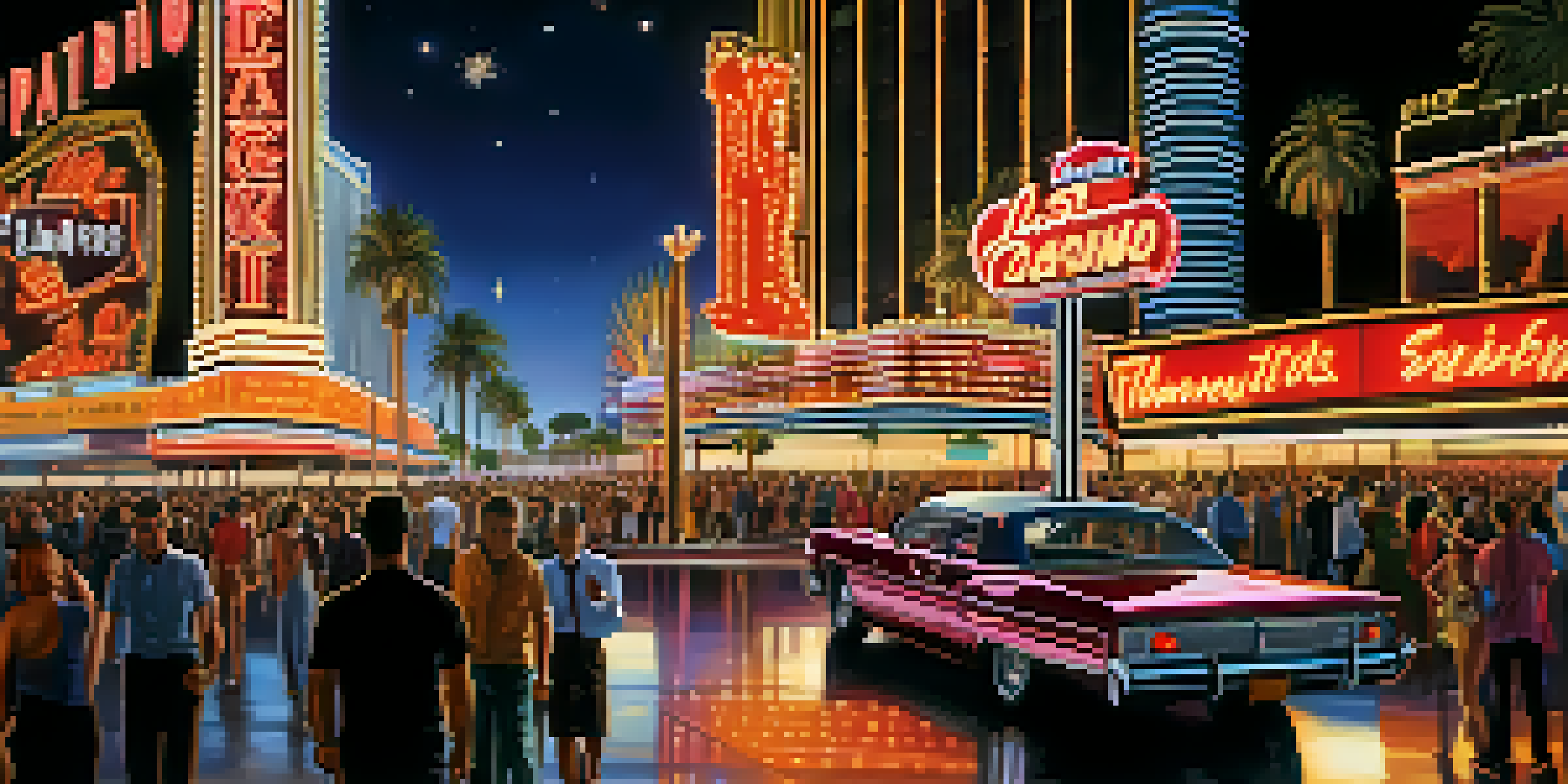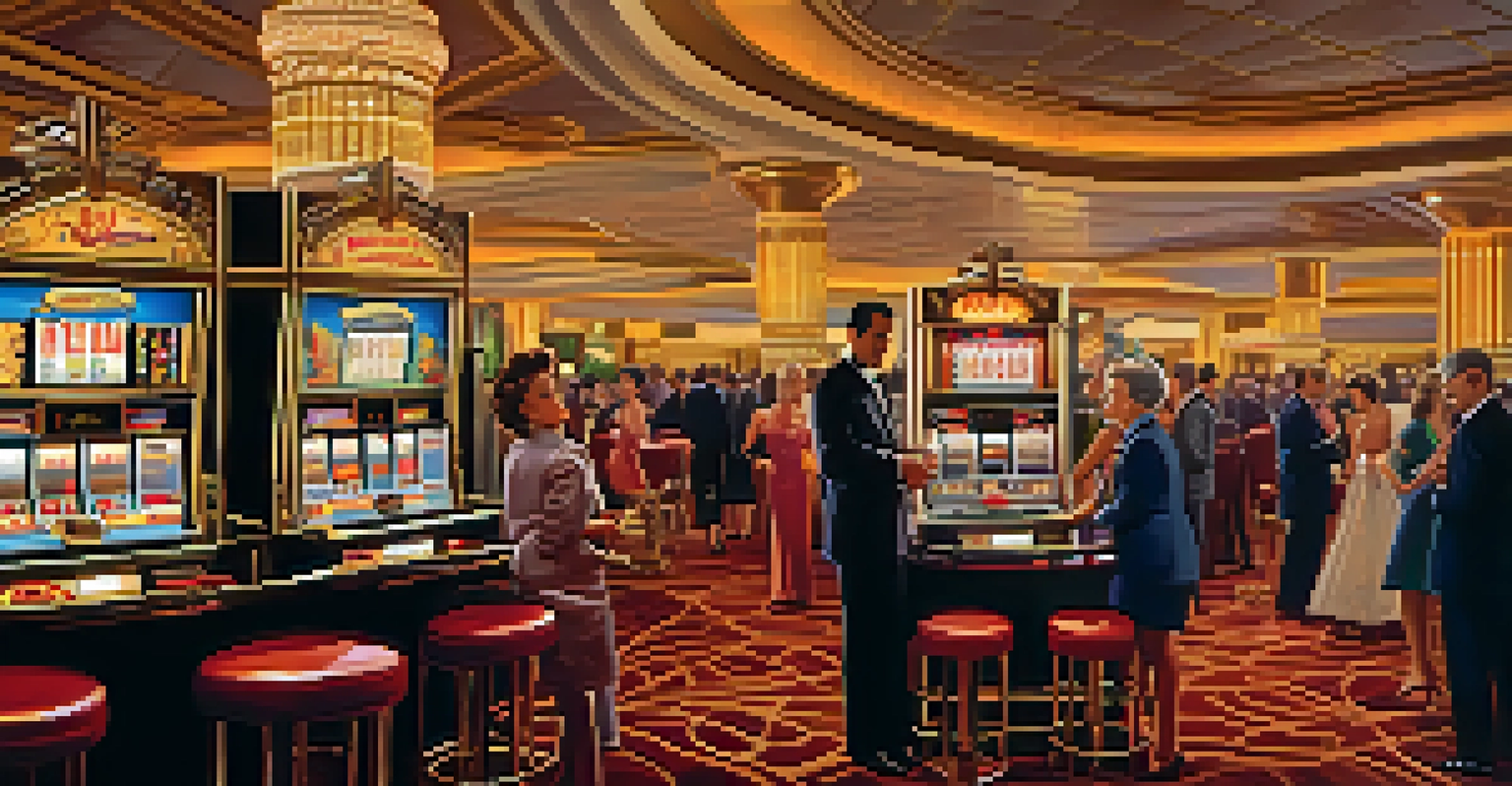The Evolution of Las Vegas Casinos: A Historical Overview

The Birth of Gaming in Las Vegas: Early Beginnings
Las Vegas' journey as a gaming hub began in the early 20th century. Initially, it was a small desert town, primarily known for its proximity to the Hoover Dam. In 1931, Nevada legalized gambling, setting the stage for a transformation that would change the landscape of the city forever.
Las Vegas is a city of contradictions, a place where dreams come true and hopes are dashed, all in the blink of an eye.
The first casinos, like the Pair-O-Dice Club, opened their doors, offering a taste of gaming to curious visitors. These establishments were modest compared to today's standards, often consisting of simple card tables and slot machines. However, they laid the groundwork for a booming industry.
This era marked the beginning of a cultural shift, as Las Vegas slowly transitioned from a quiet stopover to a destination for entertainment and excitement. The combination of gambling and tourism began to attract visitors from all over the country, igniting a unique evolution.
The Rise of the Strip: Iconic Casinos of the 1940s
The 1940s brought significant changes to Las Vegas, with the emergence of the iconic Las Vegas Strip. This stretch of road became home to some of the most famous casinos, including the Flamingo, which opened in 1946. The Flamingo was a game-changer, not just for its luxurious amenities but also for its glamorous atmosphere.

During this time, mob influence played a crucial role in the growth of these casinos. With figures like Bugsy Siegel at the helm, the gambling scene flourished, attracting high rollers and celebrities alike. The Strip transformed into a playground for the rich and famous, solidifying Las Vegas' reputation.
Las Vegas: From Desert to Gaming Hub
The legalization of gambling in 1931 transformed Las Vegas from a small desert town into a bustling gaming destination.
As more casinos began to emerge, so did entertainment options, including lavish shows and performances. This era set the stage for Las Vegas to become a cultural hotspot, blending gaming with glitz and glamour, forever changing the face of the city.
The Golden Age of Gambling: 1950s Expansion
The 1950s marked a golden age for Las Vegas casinos, with a surge in construction and innovation. Iconic venues like the Sands and the Riviera opened their doors, showcasing extravagant designs and luxurious accommodations. This decade saw an influx of visitors, eager to experience the excitement of the Strip.
The house always wins, but the thrill of the game is what keeps us coming back.
During this time, the casino experience evolved to include more than just gambling. The introduction of high-profile entertainers, such as Frank Sinatra and Elvis Presley, drew crowds and solidified Las Vegas as the entertainment capital of the world. The combination of live performances and gaming created an irresistible allure.
As the city expanded, so did the competition among casinos. Operators began to invest heavily in marketing and themed experiences, creating a vibrant landscape that catered to a diverse audience. This era not only solidified Las Vegas' status but also set the stage for future growth and development.
Changing Times: The 1960s and Beyond
The 1960s brought social changes that also impacted Las Vegas casinos. The influx of new tourists and changing demographics led to a diversification of offerings, appealing to families and casual visitors. Casinos began to expand their attractions beyond traditional gaming.
This decade saw the emergence of mega-resorts, such as the MGM Grand, which opened in 1973 and redefined the casino experience. These sprawling complexes featured hotels, restaurants, and entertainment options, transforming the way people experienced Las Vegas. It became more than just a gambling destination; it was a complete vacation experience.
Iconic Casinos Redefine Entertainment
The emergence of the Las Vegas Strip in the 1940s brought luxury casinos and entertainment, establishing the city as a cultural hotspot.
As competition grew, casinos started to innovate with new gaming options and themed experiences, further enticing visitors. The evolution of Las Vegas continued as it adapted to the changing preferences of its audience, ensuring its place as a premier entertainment destination.
The Tech Revolution: Gaming Innovations in the 1980s
By the 1980s, technological advancements began to influence the gaming industry in Las Vegas. The introduction of video poker machines and electronic gaming transformed the casino floor, offering players new ways to engage with their favorite games. This shift attracted a broader audience and increased revenue.
Casinos also started embracing marketing strategies, utilizing data to understand customer preferences and tailor their offerings. Loyalty programs emerged, encouraging repeat visits and creating a more personalized experience for guests. The combination of technology and customer focus reshaped the landscape of gaming.
As Las Vegas continued to grow, it remained at the forefront of gaming innovations. The city became a testing ground for new ideas, ensuring it stayed relevant in an ever-evolving industry. This era showcased the adaptability of the city, paving the way for future advancements.
Modern Marvels: The New Millennium and Beyond
Entering the 21st century, Las Vegas casinos began to embrace a new wave of innovation, incorporating cutting-edge technology and design. The development of resorts like The Venetian and CityCenter showcased a blend of luxury and modernity, attracting a new generation of visitors seeking unique experiences.
Online gaming also began to emerge as a significant player in the industry. As technology advanced, more people turned to digital platforms for gaming, prompting traditional casinos to adapt their strategies. This shift highlighted the need for casinos to offer both physical and online experiences to cater to evolving preferences.
Adapting to Modern Gaming Trends
Las Vegas casinos have continuously evolved, embracing technology and online gaming to meet the changing preferences of visitors.
The city's resilience was tested during challenges like the COVID-19 pandemic, but Las Vegas adapted once again. With enhanced safety measures and creative marketing strategies, casinos reinvented themselves to ensure guests felt safe and welcomed. The evolution of Las Vegas casinos continues as they strive to remain a top destination in a changing world.
Cultural Impact: Las Vegas Casinos in Society
Las Vegas casinos have not only shaped the city's identity but have also influenced broader cultural perceptions of gambling and entertainment. The glitz and glamour of the Strip have become synonymous with a carefree lifestyle, attracting dreamers and thrill-seekers from all walks of life.
Through movies, music, and television, Las Vegas casinos have become cultural icons. They serve as backdrops for countless stories, reflecting society's fascination with luck, fortune, and the pursuit of happiness. This cultural impact has helped solidify Las Vegas' position as a global entertainment capital.

As the landscape continues to evolve, the role of casinos in culture remains significant. They are not just places to gamble; they represent a unique blend of entertainment, community, and aspiration, making Las Vegas an enduring symbol of possibility in the American landscape.